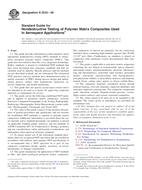1.1 This guide provides information to help engineers select appropriate nondestructive testing (NDT) methods to characterize aerospace polymer matrix composites (PMCs). This guide does not intend to describe every inspection technology. Rather, emphasis is placed on established NDT methods that have been developed into consensus standards and that are currently used by industry. Specific practices and test methods are not described in detail, but are referenced. The referenced NDT practices and test methods have demonstrated utility in quality assurance of PMCs during process design and optimization, process control, after manufacture inspection, in-service inspection, and health monitoring.
1.2 This guide does not specify accept-reject criteria and is not intended to be used as a means for approving composite materials or components for service.
1.3 This guide covers the following established NDT methods as applied to polymeric matrix composites: Acoustic Emission, Computed Tomography, Leak Testing, Radiography, Radioscopy, Shearography, Strain Measurement (contact methods), Thermography, Ultrasound, and Visual NDT.
1.4 The value of this guide consists of the narrative descriptions of general procedures and significance and use sections for established NDT methods as applied to polymer matrix composites. Additional information is provided about the use of currently active standard documents (an emphasis is placed on applicable standard guides, practices, and test methods of ASTM Committee E07 on Nondestructive Testing), geometry and size considerations, safety and hazards considerations, and information about physical reference standards.
1.5 To ensure proper use of the referenced standard documents, there are recognized NDT specialists that are certified in accordance with industry and company NDT specifications. It is recommended that a NDT specialist be a part of any composite component design, quality assurance, in-service maintenance or damage examination.
1.6 This guide summarizes the application of NDT methods to fiber- and fabric-reinforced polymeric matrix composites. The composites of interest are primarily, but not exclusively limited to those containing high modulus (greater than 20 GPa (3×106 psi)) fibers. Furthermore, an emphasis is placed on composites with continuous (versus discontinuous) fiber reinforcement.
1.7 This guide is applicable to polymeric matrix composites containing but not limited to bismaleimide, epoxy, phenolic, poly(amide imide), polybenzimidazole, polyester (thermosetting and thermoplastic), poly(ether ether ketone), poly(ether imide), polyimide (thermosetting and thermoplastic), poly(phenylene sulfide), or polysulfone matrices; and alumina, aramid, boron, carbon, glass, quartz, or silicon carbide fibers.
1.8 The composite materials considered herein include uniaxial laminae, cross-ply laminates, angle-ply laminates, and structural sandwich constructions. The composite components made therefrom include filament-wound pressure vessels, flight control surfaces, and various structural composites.
1.9 The values stated in SI units are to be regarded as the standard. The values given in parentheses are provided for information only.
1.10 This standard does not purport to address all of the safety concerns, if any, associated with its use. It is the responsibility of the user of this standard to establish appropriate safety and health practices and determine the applicability of regulatory limitations prior to use.
Product Details
- Published:
- 05/15/2009
- Number of Pages:
- 47
- File Size:
- 1 file , 480 KB
